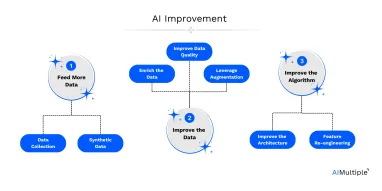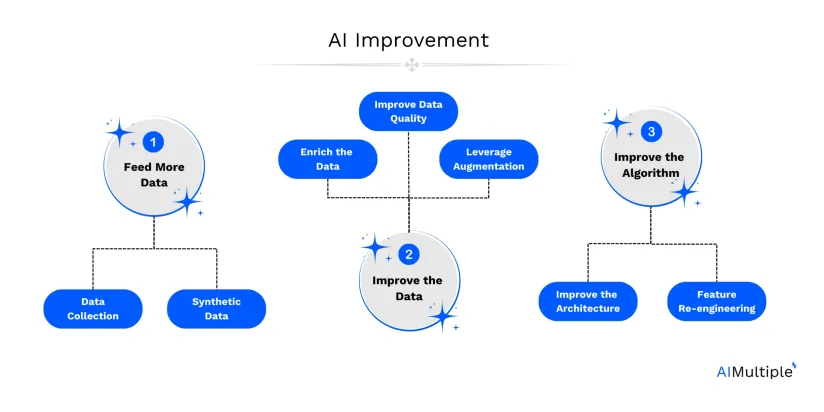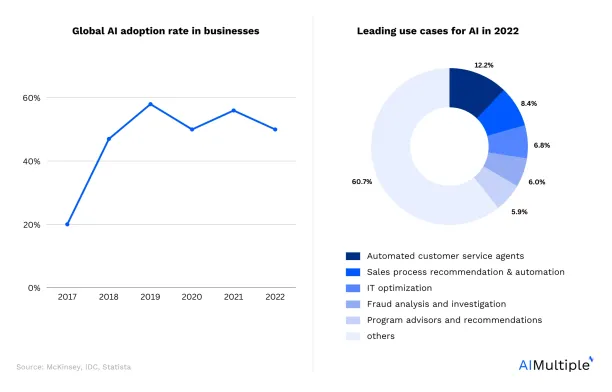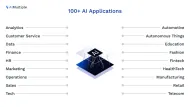Top 7 AI Improvement Recommendations & Techniques in 2024


Organizations are leveraging AI in different parts of their business (Figure 1), either by purchasing pre-build solutions or developing their own. AI and Ml models are known to degrade1 over time. It does not matter how sophisticated the algorithms are or how diverse the training dataset is; if the model is not re-trained or improved over time, it can fail to deliver the required results.
This article explores the top 7 approaches to improve your AI/Ml models to help developers and digital transformation leaders maintain or improve the level of quality achieved from their AI-powered solutions.
Figure 1. AI adoption2

Recommendations on how to approach AI/ML model improvement
This section highlights 2 recommendations on what to do before implementing the 3 AI improvement techniques mentioned in the article:
Monitor performance
You can only improve something by knowing its areas to improve. This can be done by monitoring the features of the AI/ML model. However, if all the model features can not be monitored, only a selected number of key features can be observed to study variations in their output that can impact the model performance.
Hypothesis generation
Prior to selecting the right method, we recommend performing hypothesis generation. This is a pre-decisional process to structure the decision process and narrow down the options. This process involves gaining domain knowledge, studying the problem the AI/ML model is facing, and narrowing down readily available options that can tackle the identified issues.
Top 7 ways to improve an AI/ML model
1. Feed more data
Adding new and fresh data is one of the most common and effective methods of improving the accuracy of your machine-learning model. Now that AI solutions are becoming more complex and cater to a larger user base, better and more diverse data is required to develop them.
For instance, a recent paper3 by MIT presents a complex deep-learning model that helps object detection systems understand the interactions between two objects. The paper concluded that the model is susceptible4 to dataset bias and requires complex datasets to produce results.
Research5 has also shown a positive correlation between dataset size and AI model accuracy (See figure below).
Therefore, expanding the dataset that is used for retraining the model can be an effective way to improve AI/ML models. Make sure that the data changes according to the environment it is deployed. It is also important to follow proper data collection quality assurance practices.
1.1. Data Collection
Data collection/harvesting can be used to expand your dataset and feed more data into the AI/ML model. In this process, fresh data is collected to re-train the model. This data can be harvested through the following methods:
- Private collection
- Automated data collection
- Custom crowdsourcing
Check this quick read to learn more about these data collection methods.
You can also work with an AI data service to obtain relevant datasets without the hassle of gathering data. Check out these articles to find the right data collection service for you AI project:
- Top 12 AI Data Collection Services & Selection Criteria
- Data Crowdsourcing Platform: 10+ Companies & Criteria
1.2. Synthetic data
This is another way of feeding more data into an AI/ML model. As the name implies, synthetic data is data that is created artificially rather than by real events. It is generated by using algorithms and is used for a variety of tasks, such as testing new AI/ML models, model validation, and re-training AI models. Synthetic data can be used to meet specific dataset requirements that can not be fulfilled with existing (real) datasets. Check this quick read to learn more about how synthetic data can be generated.
2. Improve the data
Improving the existing data can also result in an improved AI/ML model. It can be done through the following ways:
2.1. Enrich the data
Expanding the dataset is one of many ways to improve AI. Another important way of enhancing AI/ML models is enriching the data. This simply means that the new data that is collected to expand the dataset must be processed before feeding into the model. This can also mean improving the annotation of the existing dataset. Since new and improved labeling techniques are developed, they can be implemented on the existing or newly gathered dataset to improve model accuracy.
2.2. Improve data quality
Improving the quality of the data is also necessary for improving AI/ML models. Using a data centric approach can also help in improving the development process of AI. The quality of the data can be improved by maintaining the quality during the collection phase. You can also check this quick read to learn about how the quality of existing data can be improved.
2.3. Leverage data augmentation
Some people might confuse augmented data with synthetic data; however, both the terms have some differences. Augmented data refers to the addition of information to an existing dataset, while synthetic data is generated artificially to stand in for real data. augmented data is often used to improve the accuracy of predictions or models, while synthetic data is commonly used for testing and validation.
Check out this quick read to learn more about the different techniques of data augmentation.
3. Improve the algorithm
Sometimes, the algorithm that was initially created for the model needs to be improved. This can be due to different reasons, including a change in the population that the model is deployed on.
For instance, studies show that patients with lower income levels have a greater health risk as compared to patients with higher income levels. Suppose a deployed AI/ML algorithm that evaluates the patient’s health risk and does not include the income level parameter is suddenly exposed to data of patients with lower income levels. In that case, it is unlikely to produce fair evaluations.
Therefore, upgrading the algorithm and adding new parameters to it can be an effective way to improve model performance. The algorithm can be improved in the following ways:
3.1. Improve the architecture
There are a few things that can be done in order to improve the architecture of an algorithm. One way is to take advantage of modern hardware features, such as SIMD6 instructions or GPUs. Additionally, data structures and algorithms can be improved through the use of cache-friendly data layouts and efficient algorithms. Finally, algorithm developers can exploit recent advances in machine learning and optimization techniques.
3.2. Feature re-engineering
Feature re-engineering of an algorithm is the process of improving the algorithm’s features in order to make it more efficient and effective. This can be done by modifying the algorithm’s structure or by tweaking its parameters.
For more in-depth knowledge on data collection for AI/ML models, feel free to download our whitepaper:
Further reading
- 4 Steps and Best Practices to Effectively Train AI
- AI chips: A guide to cost-efficient AI training & inference in 2022
If you need help finding a vendor or have any questions, feel free to contact us:
Resources
- 1. Vela, D., Sharp, A., Zhang, R., Nguyen, T., Hoang, A., & Pianykh, O. S. (2022). Temporal quality degradation in AI models. Scientific Reports, 12(1), 1-12.
- 2. McKinsey, IDC. (2023). Artificial Intelligence: in-depth market analysis 2023. Statista. Accessed: 22/August/2023.
- 3. Liu, N., Li, S., Du, Y., Tenenbaum, J., & Torralba, A. (2021). Learning to compose visual relations. Advances in Neural Information Processing Systems, 34, 23166-23178.
- 4. Anyverse (February 28, 2022), “More complex deep learning models require more complex data.” Retrieved: 22/Nov/2022.
- 5. Adey, Brenton. (2021). Investigating ML Model Accuracy as Training Size Increases. Accessed: 22/Nov/2022.
- 6. Single instruction, multiple data. Wikipedia. Nov 2, 2022. Accessed: 5/Dec/2022



Comments
Your email address will not be published. All fields are required.